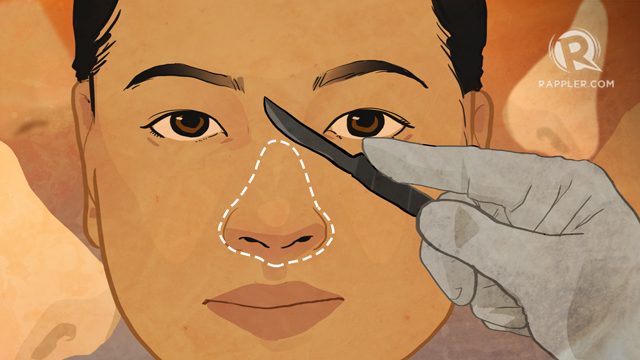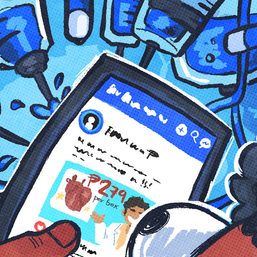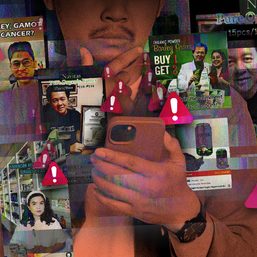SUMMARY
This is AI generated summarization, which may have errors. For context, always refer to the full article.
 When I met Melanie, 22, at the outpatient clinic of the Philippine General Hospital where I had my medical training, she was too embarrassed to say why she had come for a consult in the first place. Instead, she pointed to her nose.
When I met Melanie, 22, at the outpatient clinic of the Philippine General Hospital where I had my medical training, she was too embarrassed to say why she had come for a consult in the first place. Instead, she pointed to her nose.
I did not immediately get what her problem was. On inspection, there was nothing wrong. Finally, she said that she wanted to have it retouched. Before I referred her to the plastic surgery service that would schedule her for a nose lift, I asked her why she wants it. Her reply: “Ayoko na po na inaasar” (I’m tired of being teased).
A few years later, while watching a beauty pageant in Palawan, I overheard someone say: “Retokada yan” (She’s been retouched) as a contestant walked on the stage. Likely, she was referring to the young lady’s nose, which was more matangos (pointed) than those of the other contestants. Fair-skinned, and tall in her high heels, she would eventually win one of the coveted titles that night.
Later, I would ask Jessica, 20, herself a regular contestant in beauty pageants, what she thought of cosmetic surgery. Her reply was that of a beauty queen: “We must be content and proud of our God-given beauty.” Then she added: “But if I want to win in a national beauty pageant, my manager says it will help if I have a retouch.”
It was not always that way for Filipinos. The eminent scholar William Henry Scott wrote in Barangay (1994) that in some precolonial Philippine societies, particular in the Visayas, women took to binding their babies’ heads to produce flat foreheads and noses – an observation supported by the archeological record. Thus the late historian Henry Funtecha speculated that the early Visayans considered “broad faces with receding foreheads and flat noses handsome.”
Sharing this to my friend, Dr. Lorenz Gonzales, an otorhinolarynology resident, he said that nose variations are adaptations to various environments. Pursuing this topic further, I found an article in the American Journal of Physical Anthropology that lends credence to this view: those from cold weather need longer nasal bridges to have more space to humidify the cold air and make it suitable for inhalation. Those from warm climates – such as the Philippines – did not need such an adaptation because of the natural heat and humidity.
These cultural and physiological bases for flat noses notwithstanding, colonialism changed the way we looked at our faces, and noses. The desire for a mestizo appearance was already there during the Spanish period, as Rizal memorialized through his Noli Me Tangere’s Doña Victorina. Arguably, however, it was during the American period when the preference for “foreign-ness” reached its zenith. At the turn of the 20th century, many people, including scientists, were convinced that every “race” had a distinct set of physical characteristics, and by measuring various parts of the body, one can define various races. These differences were then used to justify Euro-American superiority – and the inferiority of others. Our physical features, thus, implicated us in a racial hierarchy that conflated beauty and status.

The modern “legend” of why Filipinos have flat noses is revelatory of how we acquiesced to this hierarchy. In this tale, it was actually a Filipino (usually a ‘Juan’) who acquired the first nose, only to lose it to an accident. But when a boatman arrived giving away free noses, he was outpaced by the others and what was left was a flat nose. This story reinforces our view of flat noses as the least desirable ones – and conversely – our preference for one that is matangos.
This preference, in turn, has given rise to practices like pulling one’s nose during Easter Sunday – and more commonly, the regular pinching of babies’ noses by their parents. Today, people exchange notes online about how best to do it (“i.e. press the nose for 10 seconds 3 times a day”). In one web forum, I saw someone recommending a device called “Nose Magic”, and another giving the following advice: “Sabi ng lola ko, sipitan daw bago matulog.” (My grandmother says clip it before sleeping).
Viewed in light of these practices, is having a nose lift – surgically altering the skin, cartilage, bones, and lining of the nose – radically different? Or can we see it as belonging to a spectrum of practices that people do to make themselves look different, beautiful?
At one level, I understand where Melanie, Jessica, and many others are coming from. Given the limited opportunities for young people, especially in the provinces and among the urban poor, having a “pleasing personality” – which for many people actually means having a (more) beautiful body – is a way to get better-paying jobs, particularly in the service sector, and win beauty pageants that can lead to scholarships and other opportunities. Perhaps for them – and the others who simply want to be more attractive or feel good about themselves – surgery is a means of liberation from the constraints imposed by their bodies.
But alongside this “liberation”, is there also not an underlying oppression: an imposition of an aesthetic that is beyond the reach of many, a colonization of bodies that renders ugly and needful of “repair” that which is naturally ours?
“Wag kang mahihiya / kung ang ilong mo ay pango” (Don’t be ashamed / if your nose is flat), wrote Heber Bartolome in his oft-revived refrain. But at a time when mestizo and Belo-fied faces dominate our TV screens and larger-than-life billboards, its message is increasingly falling on deaf ears. – Rappler.com
Gideon Lasco is a physician, medical anthropologist, and commentator on culture and current events. His essays have been published by the Philippine Daily Inquirer, Singapore Straits Times, Korea Herald, China Post, and the Jakarta Post.
Add a comment
How does this make you feel?





There are no comments yet. Add your comment to start the conversation.